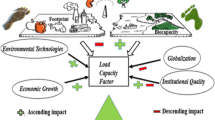Abstract
This article specifies what an optimal pollution tax should be when dealing with a vertical Cournot oligopoly. Polluting firms sell final goods to consumers and outsource their abatement activities to an environment industry. It is assumed that both markets are imperfectly competitive. Thus, the tax is a single instrument used to regulate three sorts of distortions, one negative externality and two restrictions in production. Consequently, the optimal tax rate is the result of a trade-off that depends on the firms’ market power along the vertical structure. A detailed analysis of Cournot-Nash equilibria in both markets is also performed. In this context, the efficiency of abatement activities plays a key-role. It gives a new understanding to the necessary conditions for the emergence of an eco-industrial sector.
Similar content being viewed by others
References
Barnett AH (1980). The Pigouvian tax rule under monopoly. Am Econ Rev 70(5): 1037–1041
Barton JR (1997) The north–south dimension of the environment and cleaner technology industries. Discussion paper, Institute for New Technologies, United Nations University, Maastricht
Baumol WJ (1995). Environmental industries with substancial start-up costs as contributors to trade competitiveness. Annu Rev Energy Environ 20: 71–81
Berg DR, Ferrier G, Paugh J (1998) The U.S. environmental industry. U.S. Department of Commerce Buchanan, Office of Technology Policy
Buchanan JM (1969). External deseconomies, corrective taxes and market structures. Am Econ Rev 59: 174–177
David M and Sinclair-Desgagné B (2005). Environmental regulation and the eco-industry. J Regul Econ 28(2): 141–155
Ecotech Research and Consulting Limited (2002) Analysis of the EU eco-industries, their employment and export potentials. Technical report, European Commissions, DG Environment
European Commission, DG Environment (2006) Eco-industry, its size, employment perspectives and barriers to growth in an enlarged EU. Ernst and Young Environment and Sustainability Services
Gaudet G and Salant SW (1991). Uniqueness of Cournot equilibrium: new results from old methods. Rev Econ Stud 58(2): 399–404
Greaker M (2006). Spillovers in the development of new pollution abatement technology: a new look at the Porter-hypothesis. J Environ Econ Manage 56: 411–420
Hamilton SF and Requate T (2004). Vertical structure and strategic environmental trade policy. J Environ Econ Manage 47(2): 260–269
Ishikawa J and Spencer B (1999). Rent-shifting export subsidies with an imported intermediate product. J Int Econ 48: 199–232
Kennett M, Steenblik R (2005) Environmental goods and services: a synthesis of country studies. OECD Trade and Environment Working Papers 2005/3
Kolstad CD and Mathiesen L (1987). Necessary and sufficient conditions for uniqueness of a Cournot equilibrium. Rev Econ Stud 54(4): 681–690
Levin D (1985). Taxation within Cournot oligopoly. J Public Econ 27: 281–290
Long NV and Soubeyran A (2000). Existence and uniqueness of Cournot equilibrium: a contraction mapping approach. Econ Lett 67: 345–348
Nimubona A-D, Sinclair-Desgagné B (2005) The Pigouvian tax rule in the presence of an eco-industry. FEEM. Nota de lavoro (57-2005)
Numeri I. and R.D.I. (2004) Panorama des eco-entreprises. Technical report, Ministère de l’économie et des finances
OECD (1996) The global environmental goods and services industry. Technical report
OECD (1999) The Environmental oods and services industry: manual for data collection and analysis. OCDE Editions, Paris
Okuguchi K (2004) Optimal pollution tax in Cournot oligopsonistic oligopoly. Working paper, Departments of Economics and Information, Gifu Shotoku Galuen University
Petrakis E and Xepapadeas A (2003). Location decisions of a polluting firm and the time consistency of environmental policy. Resour Energy Econ 25: 197–214
Pigou AC (1920). The economics of welfare. Macmillan, London
Simpson R (1995). Optimal pollution tax in a Cournot duopoly. Environ Resour Econ 6: 359–369
Author information
Authors and Affiliations
Corresponding author
Rights and permissions
About this article
Cite this article
Canton, J., Soubeyran, A. & Stahn, H. Environmental Taxation and Vertical Cournot Oligopolies: How Eco-industries Matter. Environ Resource Econ 40, 369–382 (2008). https://doi.org/10.1007/s10640-007-9158-8
Received:
Accepted:
Published:
Issue Date:
DOI: https://doi.org/10.1007/s10640-007-9158-8




